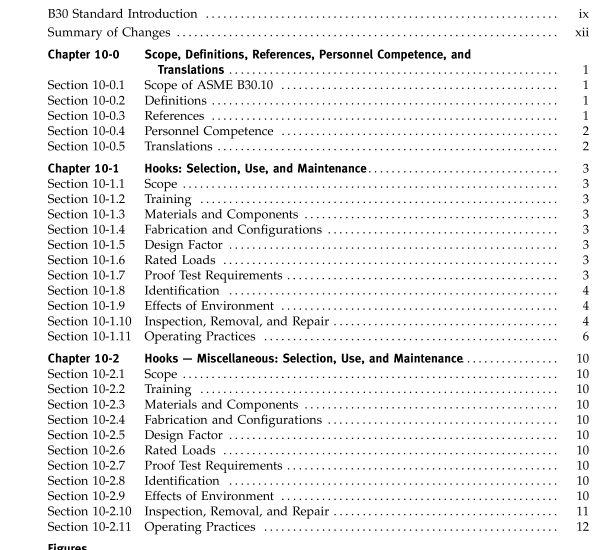ASME B30.10:2014 pdf download Hooks Safety Standard for Cableways, Cranes, Derricks, Hoists, Hooks, Jacks, and Slings
SECTION 10-0.1:scOPE OF ASME B30.10
volume B30.10 includes provisions that apply to thefabrication, attachment, use, inspection, and mainte-
nance of hooks shown in Chapters 10-1 and 10-2 used forload handling purposes, in conjunction with equipmentdescribed in other volumes of the B30 Standard.Hookssupporting a load in the base (bowl/ saddle or pinhole)
of the hook are covered in Chapter 10-1.Hooks thatmay be loaded in other than the base (bowl / saddle or
pinhole) are covered in Chapter 10-2.
abnormal operating conditions: environmental conditionsthat are unfavorable, harmful, or detrimental to or forthe use of a hook.
crack: a crevice-type discontinuity in the material.
design factor: ratio between nominal or minimum hroak-ing strength and rated load of the hook.
hook,self-closing: a hook with a throat opening that isclosed by a spring-loaded latch, gate,or bail that ismanually opened for loading and closes upon release.
It may be locked in the closed position (see Figs. 10-1.1-8through 10-1.1-14).
hook, self-locking: a hook with a throat opening that willclose and lock when a load is applied and will not open
until unloaded and the lock released (see Fias.10-1p1-hand 10-1.1-7).
latch: a mechanical device used to close the throat opening of a hook (see Figs. 10-1.1-1 through 10-1.1-5 and
10-1.1-17).A rigging aid, not intended to support theload.
load: the total force or weight imposed on the hook.load handling: the act of lifting or pulling a load fromone location to another by using a hook as the connectorbetween the load and the load handling equipment.load,proof: the specific load applied in performance ofthe proof test.
load, rated: the maximum allowable working load.Theterms rated capacity and working load limit are commonlyused to describe rated load.
ouse: a method to close the throat opening of a hookusing a device such as rope, wire, or other suitablemeans.
uick or gouge: sharp notch in hook surface that may actas stress riser in the area of the notch.
quualified person: a person who, by possession of a recog-nized degree in an applicable field or certificate of pro-fessional standing or who by extensive knowledge,training, and experience, has successfully demonstratedthe ability to solve problems relating to the subject mat-ter and work.
rated load idenfification: actual rated load information ora designation provided by the manufacturer for grade
and type or size to allow determination of hook ratedload.
serzice, heavy: service that involves operating at85% to 100%of rated load as a regular specifiedprocedure.
service,normal: service that involves operating at lessthan 85%of rated load except for isolated instances.service, severe: heavy service coupled with abnormaloperating conditions.
test , rondestructize: a test that does not destroy the func-tional use of the hook, such as, but not limited to, dye-penetrant, magnetic particle, radiography, and ultra-sonic tests.
test, proof: a nondestructive load test made to verify themanufacturing integrity of the hook.
SECTION 10-0.3:REFERENCES
The following is a list of publications referenced inthis Standard.
ISO 7000,Graphical symbols for use on equipment —Registered symbols
ISO 7296,Cranes —Graphic symbols — Parts 1-3Publisher:InternationalOrganization forStandardization (ISO),Central Secretariat,1,ch. dela voie-Creuse, Case postale 56,CH-1211 Geneve 20,Switzerland/ Suisse (iwww.iso.org)
SECTION 10-0.4: PERSONNEL COMPETENCE
Persons performing the functions identified in thisvolume shall meet the applicable qualifying criteriastated in this Volume and shall,through education, train-ing,experience, skill, and physical fitness, as necessary,be competent and capable to perform the functions asdetermined by the employer or employer’srepresentative.
SECTION 10-0.5: TRANSLATIONS
(a) Translation of Non-English Documentation lntoEnglish
(1)The wording of written non-English safetyinformation and manuals regarding use, inspection, and
